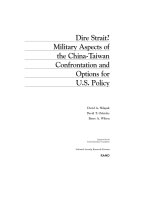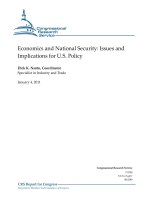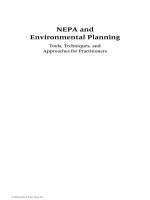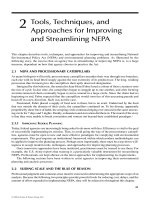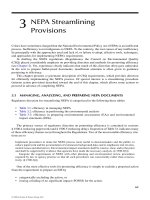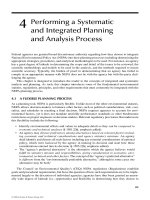NEPA and Environmental Planning : Tools, Techniques, and Approaches for Practitioners - Chapter 12 pptx
Bạn đang xem bản rút gọn của tài liệu. Xem và tải ngay bản đầy đủ của tài liệu tại đây (159.88 KB, 12 trang )
299
12
International Environmental
Impact Assessment
Not long after the now historic National Environmental Policy Act (NEPA) was enacted into law
in the United States, the international community began to realize that environmental degradation
was not only an American problem, but also a global one. Many nations around the world began
to appreciate how the environmental impact assessment (EIA) element inherent in the U.S. NEPA
process could facilitate sound economic development while providing the methodology to establish
plans and policies that would enhance public participation and help their own decision-makers
avoid making costly and damaging environmental mistakes.
12.1 NEPA AND THE INTERNATIONAL COMMUNITY
Throughout the 1970s, and continuing into the following decades, many countries moved quickly to
adopt their own versions of national environmental policies and assessment procedures.
1
So many,
in fact, that today some have postulated that NEPA may have become the most emulated statute
in the world. As described in the Introduction, the president’s Council on Environmental Quality
(CEQ) has written that, in one form or another, NEPA has been used as a pattern or copied by more
than 80 countries worldwide.
2
However, the number of nations that have adopted some version of
NEPA’s policy or EIA process may actually be much higher than this estimate. For example, Canter
reports that over 100 countries have instituted some form of EIA measures.
3
A book by John Cronin
and Robert F. Kennedy, Jr. cites an even larger number—over 125 nations.
4
Table 12.1 provides a chronological outline of some representative nations that have followed
the American footprint.
5
12.1.1 STATUS OF EIA LEGISLATION IN DEVELOPING COUNTRIES
It is remarkable how many foreign EIA processes have come to mirror NEPA’s original model,
which still remains virtually unchanged after more than 35 years. Some countries that did not ini-
tially incorporate American EIA principles, such as considering alternatives, encouraging public
participation, or investigating cumulative impacts, eventually revised their EIA processes to include
such elements. A former senior policy advisor for the president’s CEQ, Ray Clark, has written that
this is indeed a tribute to the vision that was forged in NEPA by the U.S. Congress.
6
Credit should also be given to CEQ for its own successful effort, during the Carter administration,
to convert its early nonbinding NEPA guidance into formal, legally binding regulations for imple-
menting NEPA’s procedural requirements. CEQ’s NEPA regulations (40 CFR Parts 1500–1508),
published in November 1978, claried many ambiguities regarding how federal agencies should
interpret the statutory language, set out a recommended format for environmental impact statement
(EIS) documents, and dened key terms such as effects, mitigation, scope, and signicance. These
regulations remain in effect today virtually unchanged and have served as the model for EIA imple-
mentation procedures in many other countries around the world.
Whereas some developing countries, such as the Philippines, required EIAs to be prepared for major
development projects as early as the 1970s, a few of the leading industrialized countries, such as Japan
and the Federal Republic of Germany, adopted similar requirements only many years later.
5
By one
account, developing Asian countries alone have already performed more than 15,000 EIA studies.
5
CRC_7559_CH012.indd 299CRC_7559_CH012.indd 299 2/5/2008 4:55:01 PM2/5/2008 4:55:01 PM
© 2008 by Taylor & Francis Group, LLC
300 NEPA and Environmental Planning: Tools, Techniques, and Approaches for Practitioners
12.1.2 INTERNATIONAL ORGANIZATIONS
As early as 1974, the Organization of Economic Cooperation and Development (OECD) recom-
mended that its member states adopt EIA processes. The OECD now uses an EIA process similar
to that of NEPA in granting aid to developing nations.
7
Throughout the 1980s, many developing countries continued to establish EIA processes as an
essential element of environmental policy and project planning.
12.1.2.1 United Nations
The United Nations Environmental Program (UNEP) developed guidance for performing EIAs and
since that time has strongly encouraged member states to establish EIA processes.
8
According to
the UNEP, EIA provisions now exist in the environmental legislative framework of 55 developing
countries.
12.1.2.2 World Bank
The World Bank eventually ruled in 1989 that an EIA process should normally be prepared for
those projects it provides funding. In 1991 the bank published a three-volume EIA sourcebook that
provided practical guidance for the preparation of EIA documents for various types of development
TABLE 12.1
Some Representative Nations (in Chronological Order) That Have Adopted an EIA Process
Similar to That of NEPA
Nation
Year EIA Process
Was Adopted Notes
U.S. 1969 National Environmental Policy Act
Canada 1973 Environmental Assessments Review Process (EARP)
Australia 1974 Environmental Protection (Impact of Proposals) Act, 1974
Malaysia 1974 EIA required under Section 34A, Environmental Quality Act, 1974
France 1976 National Environmental Assessment Legislation
Philippines 1978 As per Presidential Decree No. 1586
Japan 1984 Environmental Assessment implemented via a cabinet resolution
U.K. 1985 Town and Country Planning (Assessment of Environmental Effects)
Regulations 1988 (S. No. 1199)
Indonesia 1986 AMDAL (EIA) process established by law through Government Regulation
No. 29 of 1986
Netherlands 1986
New Zealand 1986
Sri Lanka 1988 National Environmental Act No. 47 of 1980 was amended to include an EIA
provision
CEC 1988 EU Directive on Environmental Assessment for 12 Member States
Norway 1989 Under the Planning Act of 1989
Germany 1990 National Environmental Assessment Legislation
Thailand 1992 Sections 46 and 47 under National Environmental Quality Act, 1992
Nepal 1993 In the form of National EIA Guidelines issued by National Planning
Commission Secretariat
India 1994 Before January 1994, obtaining Environmental Clearance from Central
Ministry was only an administrative requirement intended for mega projects
but from 1994 the EIA notication was issued
CRC_7559_CH012.indd 300CRC_7559_CH012.indd 300 2/5/2008 4:55:02 PM2/5/2008 4:55:02 PM
© 2008 by Taylor & Francis Group, LLC
International Environmental Impact Assessment 301
projects.
9
The bank’s most recent procedure claries the need for the nature and levels of environ-
mental assessment to be applied to investment projects. However, this procedure does not apply to
macroeconomic adjustment lending.
10
12.1.2.3 European Union
The European Economic Community now requires its members to comply with an environmental
process similar in nature to NEPA. Another example involves the North American Free Trade
Agreement (NAFTA), which incorporates an EIA process modeled after NEPA for evaluating
extraterritorial impacts that cross the borders of the United States, Canada, and Mexico.
As an example, a project referred to as “Nord Stream” involved construction of a 1300-mile
natural gas proposal (570 miles in Russia and 750 miles under the Baltic Sea) consisting of
two parallel natural gas pipelines with an estimated capacity of around 55 billion cubic meters
(2 trillion cubic feet) per year from Russia to Germany.
11
The pipeline project was subject to the European Union (EU) EIA Directive and Baltic Marine
Environment Protection Commission (HELCOM or Helsinki Commission) recommendations.
One of the environmental concerns was that pipeline construction might disturb the seabed
and dislodge toxic materials, including chemical munitions deposited in the Baltic Sea during and
after World Wars I and II. Other environmental groups raised concerns about potential effects on
pipeline construction activities on bird and marine life in the Baltic Sea.
12.1.2.4 NAFTA and Executive Order 13141
Under a 1994 North American agreement on environmental cooperation, the United States,
Canada, and Mexico agreed to develop recommendations covering proposed projects “likely to
cause signicant adverse transboundary effects.”
The Commission for Environmental Cooperation (CEC) is a trinational organization created at
the time NAFTA was signed to address regional environmental concerns, prevent potential trade
and environmental conicts, and promote enforcement of environmental law. In 1997, the council
of the CEC agreed to begin developing a transboundary EIA agreement.
Additionally, Presidential Executive Order 13141, issued during the Clinton administration,
directs responsible agencies to assess and consider environmental impacts of trade agreements
carefully through a process of ongoing assessment and evaluation.
12
A provision of the executive
order designates the U.S. Trade Representative and the Chair of the CEQ to develop procedures for
conducting environmental reviews in consultation with appropriate foreign policy, environmental,
and economic agencies.
12.2 FOSTERING INTERNATIONAL DEMOCRACY
As a result of NEPA, in a way never possible before, American citizens are now able to participate
in and inuence proposed federal actions that may affect their lives during the early planning
process for such actions. Arguably, no other single U.S. law has contributed so much toward
opening up the federal planning and decision-making process to its citizens.
As described in the Introduction, the effect NEPA has had in fostering international democra-
cies and promoting democratic principles is particularly noteworthy. The adoption of international
EIA processes similar to NEPA by so many countries has opened up government decision-making
processes to tens of millions of citizens around the world. A book by John Cronin and Robert F.
Kennedy Jr. has pointed out this fact:
4
NEPA, which has now been adopted in some form by over 125 countries, has become one of the great
promoters of democracy around the world.…
CRC_7559_CH012.indd 301CRC_7559_CH012.indd 301 2/5/2008 4:55:02 PM2/5/2008 4:55:02 PM
© 2008 by Taylor & Francis Group, LLC
302 NEPA and Environmental Planning: Tools, Techniques, and Approaches for Practitioners
12.3 INTRODUCTION TO THE EIA PROCESS
The International Association for Impact Assessment (IAIA) was founded in 1980 and has become
the premier international professional association for EIA and strategic environmental assessment
(SEA) scholars and practitioners. It has over 2500 members from 125 countries, publishes a pro-
fessional journal, holds annual meetings and training workshops (English is its primary working
language), and has helped to spread and improve the practice of EIA around the world. Its Web site
is www.iaia.org. The IAIA, in cooperation with the Institute of Environmental Assessment, U.K.,
denes EIA generally to mean
13
The process of identifying, predicting, evaluating and mitigating the biophysical, social, and other
relevant effects of development proposals prior to major decisions being taken and commitments made.
EIA thus aids in promoting improved decision-making and superior project development. It is
applied to proposals as diverse as land use development projects, power generation and transmission
infrastructure facilities, waste management facilities, and transportation infrastructure projects.
The requirement to implement EIA studies for activities that are likely to signicantly affect the
environment has been reected in
Principle 17 of the Rio Declaration on Environment and Development,
14
Article 5 of the Legal Principle for Environmental Protection and Sustainable Develop-
ment,
15
and
The 1987 UNEP Goals and Principles of Environmental Impact Assessment.
16
12.3.1 TYPICAL EIA PROCESS
Although the process involved in making decisions that affect the environment is not and has never
been a smooth or uniform one, the lack of prominence devoted to environmental considerations is
changing. As depicted in Table 12.2, this process has undergone a series of evolutionary changes to
reach its current state of the art.
17
Paoletto details the principal steps that an EIA process should typically include (Table 12.3).
18
The IAIA has gone beyond this fundamental guidance by producing a set of 14 basic principles
for all EIA processes (Table 12.4). These principles apply to all stages of an EIA or SEA process.
The IAIA has also established 10 operating principles for all EIA processes (Table 12.5).
13
These
operating principles describe how the basic principles outlined in Table 12.4 should be applied to
the main steps and specic activities of the EIA process (i.e., screening, scoping, identication of
impacts, and assessment of alternatives).
For additional information, the reader is referred to the text by Lee and Clive, who provide a
review from an economic and environmental context of the processes and practice of EIA in six
different parts of the developing world (Chile, Indonesia, Russia, Nepal, Jordan, and Zimbabwe,
and also three institutional studies of the World Bank, Asian Development Bank, and OECD). They
conclude with a chapter on strengthening future EIA practice from an international perspective.
19
•
•
•
TABLE 12.2
Evolution of the EIA Process
1970s Beginning with NEPA, early EIA processes focused primarily on the natural environment.
1980s Eventually social-economic assessments were accepted as elements of the process.
1990s Integrated Environmental Management (IEM) promotes principles of transparency, accountability,
and informed decision-making throughout the life cycle of a project.
1990s to present SEA emerged as a proactive tool for addressing the environment in plans and policies.
CRC_7559_CH012.indd 302CRC_7559_CH012.indd 302 2/5/2008 4:55:02 PM2/5/2008 4:55:02 PM
© 2008 by Taylor & Francis Group, LLC
International Environmental Impact Assessment 303
TABLE 12.3
Principal Steps in a Typical (Project-Level) EIA Process
1. Impact identication: The EIA process typically involves a broad analysis of the impacts of project activities with a
view to identifying those that are worthy of a detailed study.
2. Baseline study: Involves collection of detailed information and data on the condition of the project area prior to the
project’s implementation.
3. Impact evaluation: Is performed whenever possible in quantitative terms and should include the working-out of potential
mitigation measures.
4. Assessment: Assessing the environmental losses and gains with economic costs and benets for each analyzed
alternative.
5. Documentation: A document is prepared detailing the EIA process and conclusions regarding the signicance of
potential impacts.
6. Decision-making: The document is transmitted to the decision-maker, who will either accept one of the project
alternatives, request further study, or reject the proposed action altogether.
7. Post audits: These are made to determine how close to reality the EIA predictions were.
TABLE 12.4
Fourteen Basic Principles Underlying an EIA Process
Purpose Support informed decision-making and result in appropriate levels of environmental protection and
community well-being
Rigorous Apply “best-practicable” science, employing methodologies and techniques appropriate to address
the problems being investigated
Practical Result in information and outputs that assist with problem solving and that are both acceptable to
proponents and able to be implemented by them
Relevant Provide sufcient, reliable, and useable information for development planning and decision-making
Cost effective Achieve the objectives of EIA within the limits of available information, time, resources, and
methodologies
Efcient Impose minimum cost burdens in terms of time and nance on proponents and participants consistent
with meeting accepted requirements and objectives of EIA
Focused Concentrate on signicant environmental effects and key issues; that is, the matters that need to be
taken into account in making decisions
Adaptive Adjust to the realities, issues, and circumstances of the proposals under review without compromising
the integrity of the process, and be iterative, incorporating lessons learned throughout the proposal’s
life cycle
Participative Provide appropriate opportunities to inform and involve the interested and affected public,
and their inputs and concerns should be addressed explicitly in the documentation and
decision-making
Interdisciplinary Ensure that the appropriate technique and experts in the relevant bio-physical and socio-economic
disciplines are employed, including use of traditional knowledge as relevant
Credible Should be carried out with professionalism, rigor, fairness, objectiveness, impartiality, and balance,
and be subject to independent checks and verication
Integrated Address the inter-relationships among social, economic, and biophysical aspects
Transparent Should have clear, easily understood requirements for EIA content; ensure public access to
information; identify the factors that are to be taken into account in decision-making; and
acknowledge limitations and difculties
Systematic Result in full consideration of all relevant information on the affected environment, or proposed
alternatives and their impacts, and of the measures necessary to monitor and investigate residual
effects
CRC_7559_CH012.indd 303CRC_7559_CH012.indd 303 2/5/2008 4:55:02 PM2/5/2008 4:55:02 PM
© 2008 by Taylor & Francis Group, LLC
304 NEPA and Environmental Planning: Tools, Techniques, and Approaches for Practitioners
Wood also presents a well-researched comparative analysis of the legal basis for, and the prac-
tice of, EIA in six developed countries (U.S., U.K., the Netherlands, Canada, Australia, and New
Zealand) and one transitional country (the Republic of South Africa). He also includes chapters
comparing report review, decision-making, consultation and participation, benets and costs of EIA
systems, and the evolution of SEA in each of these countries.
20
12.3.2 EIA DOCUMENT CONTENT
Paoletto suggests a set of minimal elements that a typical EIA document should contain
(Table 12.6).
18
12.3.3 EIA PROBLEMS AND LIMITATIONS
The EIA process normally involves reviewing both the existing state of the environment and the
characteristics of the proposed action and its alternatives. In practice, application of the EIA process
tends to be limited to projects (although it has also been infrequently applied to programs and stra-
tegic planning). A project in the context of EIA is “an individual development or other scheme as
distinct from a suite of schemes or a strategy for development of a particular type or in a particular
region.”
21
When the EIA process is applied to broader programs or regional planning, it is often
done through the related analytical process of SEA (see below).
TABLE 12.5
Ten Operating Principles Underlying an EIA Process
Screening Determine whether or not a proposal should be subject to EIA and, if so, at
what level of detail
Scoping Identify the issues and impacts that are likely to be important
Examination of alternatives Establish the preferred or most environmentally sound and benign option for
achieving proposal objectives
Impact analysis Identify and predict the likely environmental, social, and other related effects of
the proposal
Mitigation and impact management Establish measures necessary to avoid, minimize, or offset predicted adverse
impacts and, where appropriate, incorporate these into an environmental
management plan or system
Evaluation of signicance Determine relative importance and acceptability of residual impacts
(i.e., impacts that cannot be mitigated)
Preparation of EIS or report Document clearly and impartially the impacts of the proposal, the proposed
measures for mitigation, the signicance of effects, and the concerns of the
interested public and the communities affected by the proposal
Review of the EIS Determine whether the report meets its terms of reference, provides a
satisfactory assessment of the proposal(s), and contains the information
required for decision-making
Decision-making Approve or reject the proposal and establish the terms and conditions for its
implementation
Follow-up Ensure that the terms and conditions of approval are met; monitor the impacts
of development and the effectiveness of mitigation measures; strengthen future
EIA applications and mitigation measures; and, where required, undertake
environmental audit and process evaluation to optimize environmental
management.
a
a
Whenever monitoring, evaluation, and management plan indicators are designed, it is desirable, whenever feasible, that
they also contribute to local, national, and global monitoring of the state of the environment and to sustainable
development.
CRC_7559_CH012.indd 304CRC_7559_CH012.indd 304 2/5/2008 4:55:02 PM2/5/2008 4:55:02 PM
© 2008 by Taylor & Francis Group, LLC
International Environmental Impact Assessment 305
Although the EIA process does not necessarily prevent a project from having an impact on the
environment, it frequently manages to minimize the severity of its adverse impacts.
21
Nonetheless,
there are some fundamental problems with most processes, even though EIA is widely established
as the method by which environmental impacts are studied. For example, some EIA processes only
address alternatives to the proposed project in a limited manner; that is, by the project assessment
stage, a number of options having potentially different environmental consequences from the cho-
sen one are likely to already have been eliminated.
12.3.4 DISADVANTAGES OF PROJECT-SPECIFIC EIAS
Sadler describes some disadvantages of project-specic EIAs:
22
Provide an analysis in a “stand-alone” process, which may be poorly related to the project
cycle
Restricted ability to address cumulative impacts, particularly for large development projects
where secondary development could occur
Restricted opportunities for effective public participation in planning or decision-making
processes
Because project-level EIA often precludes consideration of alternative strategies, locations, and
designs, at least one EIA practitioner argues that, in effect, “an EIA at the project level is essentially
damage control.”
23
Application of EIA at a more strategic level can promote a more effective assess-
ment of alternatives and cumulative impacts at an earlier stage in the decision-making process. It
can also facilitate consideration of a wider range of actions over a greater area.
21
12.4 INTRODUCTION TO SEA
The formulation of policy and plans plays an important role in shaping the direction of frameworks
and guidelines for development and resource management. A relatively recent innovation involves
the concept of SEA. In essence, it extends the application of EIA to the level of policies, plans, and
programs (PPPs). A key distinction between EIA and SEA is that SEA can be applied to PPPs at
an earlier stage than individual projects. Thus SEA allows for environmental considerations and
•
•
•
TABLE 12.6
Basic Elements Addressed in a Typical EIA Document
1. Provide a brief nontechnical summary of the information provided in the
following items
2. Indicate any uncertainties and gaps in information
3. Describe the proposal
4. Describe the affected environment
5. Describe practical alternatives (as appropriate)
6. Assess potential environmental impacts of the proposal (proposed action
and alternatives), including short-term and long-term effects, and the
direct, indirect, and cumulative impacts
7. Indicate whether the environment of any other state/province or areas
beyond national jurisdiction are likely to be affected by the proposal
8. Identify and describe practical measures (including their effectiveness)
for mitigating signicant adverse environmental impacts of the proposed
activity and alternatives.
CRC_7559_CH012.indd 305CRC_7559_CH012.indd 305 2/5/2008 4:55:03 PM2/5/2008 4:55:03 PM
© 2008 by Taylor & Francis Group, LLC
306 NEPA and Environmental Planning: Tools, Techniques, and Approaches for Practitioners
objectives to be viewed positively as inherent elements of the planning process, rather than just as
problems to be mitigated after other development decisions have been made.
The term SEA can be dened as
A process of anticipating and addressing the potential environmental consequences of proposed
initiatives at higher levels of decision-making. It aims at integrating environmental considerations
into the earliest phase of policy, plan or program development, on a par with economic and social
considerations.
21
SEAs are being used increasingly at the initial stages of decision-making to assess the consequences
of PPPs. Countries such as the United States, Australia, Canada, Denmark, and New Zealand have
already applied SEA in developing plans and policies.
24
Some aid agencies in Africa have also
started to use them.
25
Slowly, but ever more frequently, SEA is being recognized as a proactive tool for promoting
sustainable development that may also serve to reduce the number of required project-specic EIAs.
Planners may use it as a method to assess different ways for accomplishing sustainability policies.
Chapter 13 provides an overview of the concept of sustainability.
12.4.1 GOALS OF SEA
The disadvantages and weaknesses of project-specic EIAs have led to the development and appli-
cation of SEA. Sadler announces the rationale for SEA as the need to
facilitate the application of sustainability principles and guidelines, for example, by focus-
ing on the maintenance of a chosen level of environmental quality rather than by minimiz-
ing individual impacts;
focus on project-specic EIA by ensuring that issues of need, proposal generation, and
alternatives are addressed at the appropriate policy, plan, or program level; and
improve the scope and assessment of cumulative impacts, particularly where large projects
stimulate secondary development and where many small developments not requiring EIAs
may occur.
23
12.4.1.1 Performance Criteria
As depicted in Table 12.7, the IAIA has established performance criteria that SEA analyses should
meet.
13
12.4.2 RELATIONSHIP BETWEEN SEA AND EIA
The concepts of EIA and SEA differ fundamentally in both the scope and nature of their approaches.
The difference between the two processes is evident in the scale of their frameworks. The scope of an
SEA tends to be much broader, both temporally and geographically, than for project-specic EIAs
and allows consideration of alternatives and a better programmatic view of the “bigger picture.”
In an ideal world, project-specic EIAs should be prepared once a policy has been established
via an SEA. The EIA provides information about the likely environmental impacts of an individual
project and is useful in implementing mitigation measures.
For example, if a government agency decides to develop a national wind power program, EIAs
can be used to minimize the environmental damage from building specic power stations, but
cannot practically address the more fundamental questions regarding design of the national wind
power program. In contrast, an SEA could effectively lay out the overall policy and investigate the
programmatic impacts associated with such a policy.
•
•
•
CRC_7559_CH012.indd 306CRC_7559_CH012.indd 306 2/5/2008 4:55:03 PM2/5/2008 4:55:03 PM
© 2008 by Taylor & Francis Group, LLC
International Environmental Impact Assessment 307
12.4.2.1 Comparison of SEA and EIA
McDonald and Brown have written that
26
EIA tends to focus on the mitigation of impacts of proposed activities rather than determining their
justication and siting.
Perhaps the most signicant way in which SEA differs from EIA is that SEA is a proactive tool for
environmental management, whereas EIA tends to be used reactively to assess specic development
proposals. Some fundamental differences between SEA and EIAs are summarized in Table 12.8.
SEA and EIA also tend to be applied at different stages of plans and policies and to different
levels of decision-making. Such a tiered approach is employed in New Zealand, the EU, and the
United States.
17
Under a tiered approach, SEA is used to formulate strategies and policies in a pro-
active way. These policies and strategies create a framework against which specic development
proposals and projects can then be assessed using EIA.
Swedish planners have used SEA to ensure that plans and environmental goals encourage sus-
tainable development.
27
TABLE 12.7
SEA Performance Criteria
Integrated • Ensure adequate environmental assessment of all strategic
decisions relevant for the achievement of sustainable development
• Address interrelationships of biophysical, social, and economic
aspects
• Tier to policies in relevant sectors and (transboundary) regions and,
where appropriate, to project EIA and decision-making
Sustainability-led • Facilitate identication of development options and alternative
proposals that are more sustainable
Focused • Provide sufcient, reliable, and usable information for development
planning and decision-making
• Concentrate on key issues of sustainable development
• Customize analysis to the characteristics of the decision-making
process
• Cost- and time-effective
Accountable • Is the responsibility of the leading agencies for the strategic
decision to be taken?
• Is carried out with professionalism, rigor, fairness, impartiality, and
balance?
• Is subject to independent checks and verication?
• Documents and justies how sustainability issues were taken into
account in decision-making
Participative • Informs and involves interested and affected public and government
bodies throughout the decision-making process
• Addresses their inputs and concerns in documentation and
decision-making
• Provides clear, easily understood information requirements and
ensures sufcient access to all relevant information
Iterative • Ensures availability of the assessment results early enough to
inuence the decision-making process and inspire future planning
• Provides sufcient information on the actual impacts of
implementing a strategic decision, to judge whether this decision
should be amended and to provide a basis for future decisions
CRC_7559_CH012.indd 307CRC_7559_CH012.indd 307 2/5/2008 4:55:03 PM2/5/2008 4:55:03 PM
© 2008 by Taylor & Francis Group, LLC
308 NEPA and Environmental Planning: Tools, Techniques, and Approaches for Practitioners
PROBLEMS
1. Does the World Bank require a process similar to NEPA for funding international develop-
ment projects?
2. Why has it been said that NEPA promotes international democracy?
3. Does the typical EIA process described in Table 12.3 parallel that of NEPA? Explain.
4. Which characteristics outlined in Table 12.4 are inherent in NEPA?
5. What is the closest equivalent under NEPA to an SEA?
REFERENCES
1. Biswas A. K. and Agarwala S. B. C. (eds.) (1992). Environmental Impact Assessment for Developing
Countries, Butterworth-Heinemann, Oxford, U.K.
2. House of Representatives, Committee on Resources, 105th Congress, Problems and Issues with the
National Environmental Policy Act of 1969. Oversight Hearing before House Committee on Resources,
One Hundred Fifth Congress, Second Session, March 18, 1998. Serial no. 105–102, U.S. Government
3. Canter L. W. (1996). Environmental Impact Assessment, 2nd ed., McGraw-Hill, New York.
4. Cronin J. and Kennedy R. F. Jr. (1997). The Riverkeepers, Scribner, New York, pp. 37 and 175.
5. Prasad M. and Biswas A. K. (1999). Conducting Environmental Impact Assessment in Developing
Countries, United Nations University Press, Tokyo, p. 375.
6. Clark R. and Canter L. (eds.) (1997). Environmental Policy and NEPA: Past, Present, and Future,
St. Lucie Press, Boca Raton, FL, chapter 7.
7. OECD (1992). Good Practices for Environmental Impact Assessment of Developing Projects. Develop-
ment Assistance Committee, Paris.
8. UNEP (1988). Environmental Impact Assessment: Basic Procedures for Developing Countries, Regional
Ofce for Asia and the Pacic, Bangkok.
9. World Bank (1991). Environmental Impact Assessment Sourcebook (vols. 1–3), World Bank,
Washington, D.C.
10. Operational Policy (OP)/Bank Procedures (BP) 4.01, January 1999.
11. DOE, NEPA Lessons Learned, March 1, 2007, issue no. 50.
12. Executive Order 1314, Environmental Review of Trade Agreements, 64 FR 63167, November 18, 1999.
TABLE 12.8
Comparison of SEA with EIA
SEA EIA
Proactive and informs stakeholders about development
proposals
Reactive; applied to the development of site-specic
proposals
Evaluates impacts on development needs and opportunities Evaluates impacts of proposed development on the
environment
Considers areas, regions, or sectors of development Considers specic projects
Tends to be a continuing process over a life cycle that is
aimed at providing information at the right time
Has a dened beginning and end
Evaluates cumulative impacts and identies issues for
sustainable development
Focuses on direct impacts and benets
Focuses on maintaining a chosen level of environmental
quality
Focuses on mitigating impacts
Has a broader perspective and a correspondingly lower
level of detail, providing an overall vision
Has a narrow perspective with a higher level of detail
Creates a basis against which impacts and benets can be
measured
Focuses on project-specic impacts
CRC_7559_CH012.indd 308CRC_7559_CH012.indd 308 2/5/2008 4:55:03 PM2/5/2008 4:55:03 PM
Printing Office, Washington, D.C.
© 2008 by Taylor & Francis Group, LLC
International Environmental Impact Assessment 309
13. International Association for Impact Assessment and Institute of Environmental Assessment, UK,
Principles of Environmental Impact Assessment Best Practice, January 1999, />Publications/Guidelines_Principles/Principles%20of%20IA.pdf.
14. United Nations, A/CONF.151/26 (vol. I), 12 August 1992, Report of the United Nations Conference on
Environment and Development (Rio de Janeiro, 3–14 June 1992).
15. Adopted by the Experts Group on Environmental Law of the World Commission on Environment and
Development.
16. UNEP, Working Group on Environmental Law, adopted by the UNEP Governing Council at its 14th
session.
17. CSIR, CSIR Report, Strategic Environmental Assessment (SEA): A Primer, ENV/S-RR 96001,
September 2, 1996.
18. Paoletto G. Lecture Notes, Environmental Impact Assessments (EIA), />lecture-notes.html.
19. Norman L. and George C. (eds.) (2000). Environmental Assessment in Developing and Transitional
Countries, John Wiley & Sons, Chichester, U.K.
20. Christopher W. (2003). Environmental Impact Assessment: A Comparative Review, 2nd ed., Prentice
Hall (Pearson Education), Harlow, U.K.
21. Therivel R., Wilson E., Thompson S., Heaney D., and Pritchard D. (1992). Strategic Environmental
Assessment, Earthscan, London.
22. Sadler B. (1995). Towards the Improved Effectiveness of Environmental Assessment. Executive
Summary of Interim Report Prepared for IAIA 95. Durban, South Africa.
23. Robert B. S. (former member of the President’s Council on Environmental Quality) (2007), personal
communication.
24. Sadler B. and Verheem R. (1996). Strategic Environmental Assessment: Status, Challenges and Future
Directions, the Netherlands: Ministry of Housing, Spatial Planning and the Environment.
25. Goodland R., Mercier J. -R., and Muntemba S. (eds.) (1996). Environmental Assessment (EA) in Africa:
A World Bank Commitment. Proceedings of the Durban (South Africa) Workshop, June 25, The World
Bank, Washington, D.C.
26. McDonald G. T. and Brown L. (1995). Going beyond environmental impact assessment: Environmental
input to planning and design. Environmental Impact Assessment Review 15:483–495.
27. Eggiman B. (2000). Fysisk planering med strategisk miljöbedömning (SMB) för hållbarhet. En teoretisk
diskussion och förslag till SMB-process med Stockholms stad sommodell. Karlskrona and Stockholm,
Swedish Board of Housing, Building and Planning and Swedish Environmental Protection Agency.
CRC_7559_CH012.indd 309CRC_7559_CH012.indd 309 2/5/2008 4:55:03 PM2/5/2008 4:55:03 PM
© 2008 by Taylor & Francis Group, LLC
CRC_7559_CH012.indd 310CRC_7559_CH012.indd 310 2/5/2008 4:55:03 PM2/5/2008 4:55:03 PM
© 2008 by Taylor & Francis Group, LLC

